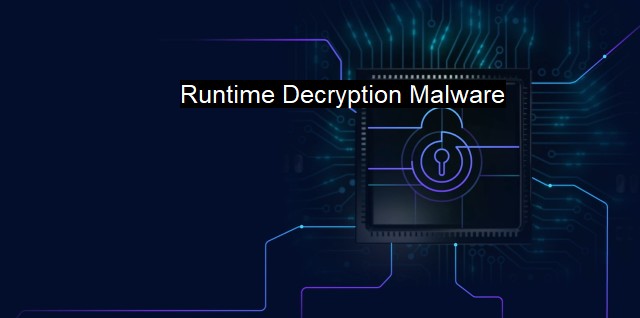What is Runtime Decryption Malware?
Runtime Decryption Malware: Understanding the Risks and Challenges of Detection
Runtime decryption malware represents one of the most sophisticated strands of malicious software in cyber-security. It is a destructive phenomenon permeating the cyber world, creating a challenging anomaly for experts, especially those in antivirus content protection. Embodying a higher level of complexity than standard malware, runtime decryption malware darkens the path of digital forensics and incident response due to its hard-coded encryption procedures.As the name suggests, runtime decryption malware decrypts its harmful components upon execution rather than beforehand."Decrypt at runtime" means that the instructions of the code are only converted from their encoded form into their original representation when the infected application is running. This phenomenon adds substantially troubling difficulties to the world of information security because it shrouds the malicious code in layers of protective covert operations.
When conventional malware infects a system, it is directly executable and less effort is required to understand and neutralize its functioning. it's a completely different screenplay with runtime decryption malware. The malign code is embedded stratagemly in numerous layers of encryption making it hard to interpret the underlying functionality.
The semantics of runtime decryption malware in the field of cybersecurity and antivirus protection births complex challenges. By taking advantage of encryption codes that typically offer protection and convert it into an ingenious yet deceptive access into data security systems; it damages resource integrity, corrupts data and files, and ultimately undermines the smooth operation of entire IT infrastructures. More than just compromising security, it poses risk to business continuity, confidentiality and overall data management policies.
Runtime decryption malware dynamicity gives it the edge over conventional antivirus systems. Traditional cyber protection system does away with malware by recognizing systems' anomalies caused by predefined patterns or signatures replicated by viruses. The decryption capability of new-generation malware makes it almost impossible to detect them using simple pattern recognition techniques. Runtime decryption undoes the malware scanning behaviours, hiding its signature among millions of possible keys, making it not just difficult, but often impossible to locate amongst masses of legitimate code.
Understanding the underlying functionality of runtime decryption malware is feasible when executed in controlled sandbox environments. While exercising this, researchers can develop malware homologues to analyze inserting actions, HTTP requests, patterns in memory and execution flows; this learnt behaviour adds codes keys into existing antivirus databases, eventually, posing as a rescuer in stranded decoding stages. Nonetheless, building such a database is infuriatingly slow and results in a race that defenders will always be battling to stay one step ahead.
Getting around runtime decryption malware defects revolves around designing antivirus products with the capability to formulate real-time responses. Advanced protection systems, equipped with artificial intelligence and machine learning, use behavior-based models to identify and dismantle these viruses before they cause serious damage.
Lastly, runtime decryption malware unearths pertinent issues toward cybersecurity education and awareness. Recognizing the joint effect of our connected systems enlightens how crucial maintaining the health and security of every device not only affects the user but the broader network integrity. Stakeholder education includes teaching internet-safe habits, how to spot phishing attempts, the importance of software updating, and sensible data management practices.
Runtime decryption malware symbolizes the expanding frontier in cybersecurity battles. It lays bare the continuous need for the development of progressive antivirus solutions. To combat it, forensic teams are relentlessly working on executing new approaches and technologies. Amidst all these challenges, organizations need to emphasize cybersecurity education, contributing to the origin-and-solution cycle of data threats and cybersecurity. With the perpetual push-pull of offense and defense, the cybersecurity universe remains a vigorous field of uninterrupted evolution, adaptation, and progress.

Runtime Decryption Malware FAQs
What is runtime decryption malware?
Runtime decryption malware is a type of malicious software that uses sophisticated obfuscation techniques to hide its true code from security software. It decrypts itself at runtime, which makes it much more difficult for antivirus programs to detect and block it.How does runtime decryption malware work?
Runtime decryption malware works by encrypting its own code and then decrypting it at runtime. This means that the malware's code is not present in its decrypted form until it is actually running on the target machine. Once the malware is running, it can use additional obfuscation and evasion techniques to avoid detection and analysis by security software.What are the risks associated with runtime decryption malware?
The main risk associated with runtime decryption malware is that it can remain undetected by antivirus software and other security measures. This can allow the malware to perform a wide range of malicious activities, such as stealing sensitive data, installing additional malware, or hijacking the victim's computer for use in a larger attack.How can I protect myself from runtime decryption malware?
To protect yourself from runtime decryption malware, it is important to use a combination of security measures, including antivirus software, firewalls, and intrusion detection systems. In addition, you should exercise caution when downloading and opening files or clicking on links, especially if they come from unknown or suspicious sources. Regularly updating your operating system and software can also help to prevent vulnerabilities that malware can exploit.| | A | | | B | | | C | | | D | | | E | | | F | | | G | | | H | | | I | | | J | | | K | | | L | | | M | |
| | N | | | O | | | P | | | Q | | | R | | | S | | | T | | | U | | | V | | | W | | | X | | | Y | | | Z | |
| | 1 | | | 2 | | | 3 | | | 4 | | | 7 | | | 8 | | |||||||